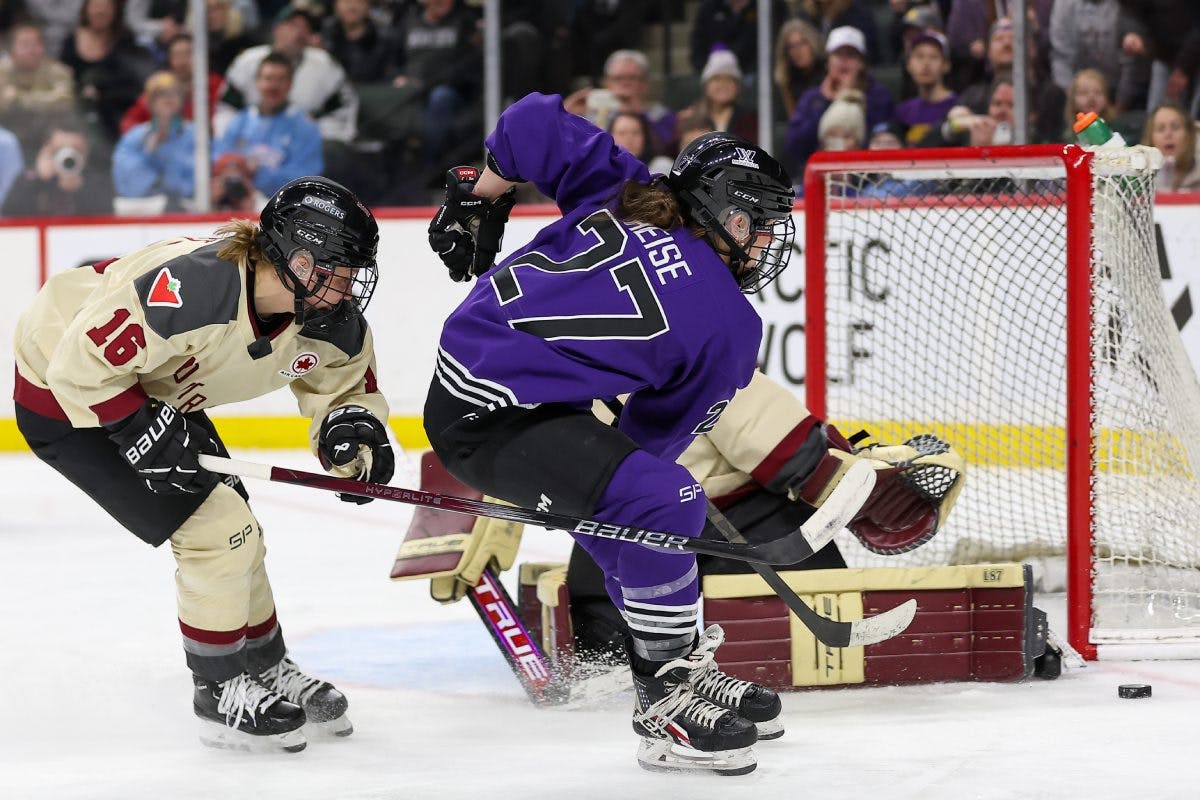‘Mindblowing’ virtual reality proving to be an effective hockey training aid for pros

This article was written by Andrew Willis, who is part of the Professional Hockey Writers Association x To Hockey With Love Mentorship Program. This program pairs aspiring writers with established members of the association across North America to create opportunities for marginalized people that do not traditionally get published on larger platforms covering hockey.
To Hockey With Love is a weekly newsletter covering a range of topics in hockey – from the scandals of the week to providing a critical analysis of the sport.
_____
Virtual reality continues to impact how hockey players train and compete at all levels.
Players often use the headsets to simulate real-life situations and increase reaction time.
“I do like using it, I feel that it’s very beneficial,” said Professional Women’s Hockey League top pick Taylor Heise. “When I use it, I definitely feel more connected to the game.”
USA Hockey’s director of player development Roger Grillo summed it up as “mindblowing.”
“It’s so realistic, you feel like you’re on the ice,” he said.
Heise, USA Hockey, and several NHL teams have used Sense Arena, a virtual reality sports training platform originally launched in 2018. The platform combines the latest in virtual reality technology with hockey drills developed in partnership with programs like USA Hockey and enables training in non-hockey environments.
USA Hockey announced a partnership with Sense Arena last April. Grillo said the partnership was formed after the company approached him and USA Hockey a couple of years prior.
“They saw some talks I gave about hockey sense and players’ ability to make reads, and reached out with the idea of getting USA Hockey involved,” said Grillo.
Improved awareness and on-ice decision making are just two of the mental benefits the platform boasts it can provide for players utilizing the product. The data on the company’s website states players using the VR system get 10 times more puck touches than a typical practice session, and 98 per cent of their user base sees an increase in hockey IQ after only one month of use.
Sense Arena was unable to be reached for comment on those data points, though Grillo touted the technology, “The hardest piece of the game for coaches to coach is the mental side,” he said.
“This tool forces athletes to make a decision and puts players in a safe, positive, environment to fail in. There’s no bad decisions, as long as they’re making a decision.”
Grillo’s testimony backs up preliminary research into the impacts VR training has on hockey athletes. A 2015 research study from Concordia University in St. Paul, Minnesota concluded that the use of virtual reality training can improve an athlete’s shot accuracy and velocity.
Another study from Charles University in the Czech Republic in 2021 found that players training with virtual reality programs see positive impacts on ice-hockey specific game skills, such as tracking multiple objects and spatial recognition.
In Jan. 2024, Team USA won the gold medal at the IIHF’s World Junior Championship. The team, operating under the USA Hockey banner, has access to VR training.
Grillo was unable to say for certain if any of the roster players from Team USA’s recent WJC gold medal winning squad used the platform in their training, saying that adoption of the VR training has widely been on an individual basis amongst players.
“It’s been more of an individual type thing, but I do think it’s going to explode,” says Grillo.
“You don’t have to go anywhere, put your skates on. You can sit in your living room and make reads.”
That convenience may be driving more players to the technology.
“I love using the tipping option,” Heise said.
“You get to practice tipping pucks, and as much as you want to sit in front of the net and let friends shoot at you, that’s not always the most ideal option. That’s something I really enjoy doing, that’s probably one of my favorite things.”
Goalies have also embraced the technology. The Buffalo Sabres’ Devon Levi and Seattle Kraken’s Joey Daccord have used virtual reality to enhance their performance. Despite its widespread use, there’s still some reluctance.
Heise says superstitions may play a role in that hesitancy.
“It kind of just depends on your personality,” she said.
“Some people are really superstitious, some people aren’t. I really think if this was something during COVID, I think it would have taken off a lot faster, and there would be more talk about it.”
Grillo, however, feels that right now is just the start of more widespread use of VR in sports.
“It’s an opportunity to use modern technology to help athletes and get players things that they might not be getting in a more unstructured era of hockey,” said Grillo.
“It’s a beneficial training tool for anybody. The results speak for themselves.”
_____
More from the PHWA x To Hockey With Love Mentorship Program
- ‘It opened a lot of doors for me that I didn’t see’: How Sidney Crosby’s Little Penguins sparked hockey aspirations for women in Western Pennsylvania
- Across the Pacific: Jordan Spence’s journey to the NHL
- ‘No one thought he’d make it’: How Alex Laferriere fought his way to the Los Angeles Kings
- Lasting Impact: How Jon Merrill’s LGBTQ+ allyship prevails